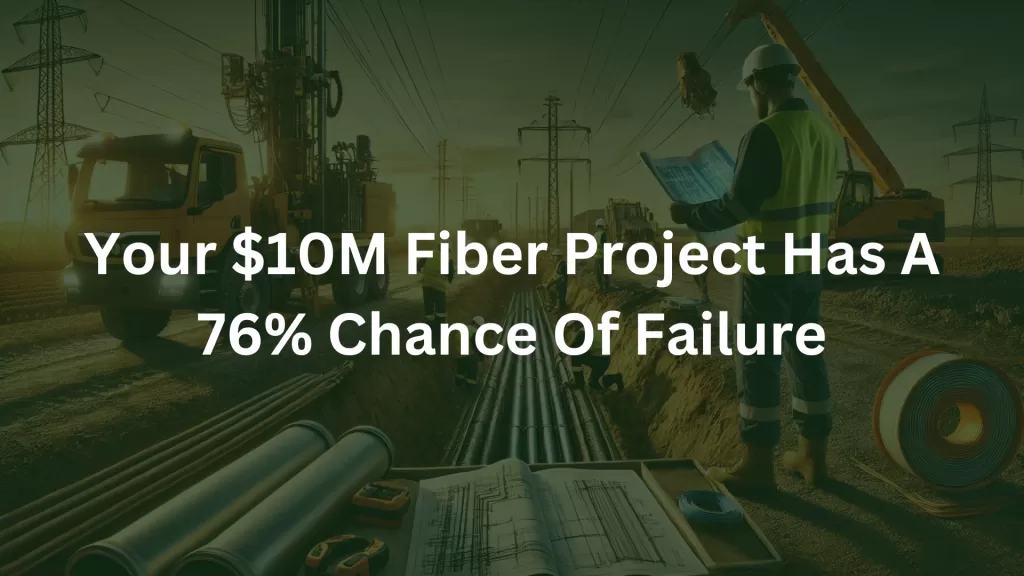
The Problem Every Leader Fears
You’ve worked hard to bring fast internet to your community. You finally got $10 million to start building, and everything seems to be moving forward.
But deep down, you have questions:
- What if the network doesn’t last?
- What if contractors are skipping steps?
- What if we spend all this money, and it doesn’t work right?
The truth is, lots of leaders like you have the same worries. And here’s the scary part, they’re right to worry. Most big fiber projects go wrong because of things no one talks about.
The Problems No One Tells You About
Common Mistakes Leaders Make
Leaders often rush to get things done and make these mistakes:
- They hurry to finish the design to meet deadlines.
- They pick the cheapest contractors, thinking they’re saving money
- They trust people without asking the right questions.
- They forget how tricky underground work can be.
These might seem small, but they can lead to big problems later.
Hidden Costs You Didn’t Plan For
When things go wrong, they cost more than you expect:
- Redoing work: Fixing mistakes can cost hundreds of thousands of dollars.
- Maintenance troubles: Bad builds need more repairs every year.
- Unhappy customers: Delays mean people cancel their service.
- Fines and penalties: Missing deadlines could lose you funding or bring lawsuits.
A Real-Life Example
One company (we’ll call them BrightNet) got $15 million to build a network. They hired a contractor who promised to be fast and cheap. But the contractor didn’t check for underground utilities properly. They hit pipes, causing $100,000 in damage and delaying the project by four months.
BrightNet learned the hard way: “Fast and cheap” often turns into “slow and expensive.”
Why Quick Fixes Make It Worse
When things go wrong, most leaders:
- Spend more money to fix problems.
- Hire extra consultants.
- Push contractors to work faster.
But these quick fixes usually make things messier. The real problems don’t get solved, and costs just keep going up.
The Fiber Industry’s Big Problem
What Most Companies Do Wrong
Most companies:
- Use old ways of managing projects that don’t work for today’s fast-moving fiber industry.
- Care more about finishing fast than building it right.
- Don’t communicate well between engineers, builders, and managers.
Why These Approaches Fail
When you wait until a problem shows up to fix it, it’s already too late. Fixing mistakes later costs way more than doing it right from the start.
The Cost of Doing Nothing
Here’s the truth:
- 76% of fiber projects have delays or go over budget.
- Poorly planned networks cost 35% more to maintain over 10 years.
- Delays make customers cancel their service, costing companies even more money.
It’s not just about the money. Your board of directors loses trust. Your team feels stressed. And the people in your community, who need internet, are stuck waiting.
Think of Fiber Like Building a House
Building a fiber network is a lot like building a house:
- Design: The blueprint is your plan. If the plan is bad, the house won’t stand up.
- Build: This is like putting up walls and laying plumbing. If the work is sloppy, you’ll have leaks and cracks later.
- Testing: Think of this as a home inspection. It checks if everything works before you move in.
If you skip any of these steps or don’t do them right, the whole project can fail.
How Central States Utilities (CSU) Can Help
At CSU, we’ve seen these problems before, and we’ve built a system to fix them.
Here’s What We Do Differently
1. Smart Design
- We work with you to plan for every challenge, like tough soil or underground pipes, before the build starts.
2. Careful Building
- Our teams follow strict steps, like checking underground utilities and using the best equipment. We keep you updated every step of the way.
3. Thorough Testing
- Before anything goes live, we test the network to make sure it works perfectly. No surprises, no delays.
Real Results
Last year, we helped a city that was six months behind on their project. By fixing their design and build plans, we cut delays by 40% and finished under budget. The city launched their network on time, and their community finally got the internet they needed.
What Should You Do Now?
This is your chance to get it right the first time. Every day you wait, the risks get bigger, and the costs go up.
Here’s how to start:
1. Call CSU for a free consultation to spot problems before they start.
2. Download our Fiber Deployment Checklist to see what a successful project looks like.
3. Commit to doing it right the first time.
This project isn’t just about fiber. It’s about your legacy as a leader and how your work helps your community.
So, here’s the big question:
Will your project set a new standard—or make the same mistakes others have?
Let’s make sure it’s the first one.
